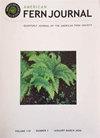更多关于非本地蕨类植物在佐治亚州和美国东南部的传播
IF 0.9
4区 生物学
Q4 PLANT SCIENCES
引用次数: 0
摘要
摘要相对于其他维管植物,蕨类植物在外源植物扩散到自然区域并可能取代本地物种方面的潜力一直被忽视。在乔治亚州东北部的皮埃蒙特,一个不寻常的地方发现了两种显然已经归化的外来蕨类植物。该遗址的第三个物种代表了另一种非本地蕨类植物在自然环境中的外观,其栽培品种和杂交品种正作为观赏植物被更广泛地种植。对来自乔治亚州和美国东南部的植物标本馆标本的检查澄清了一些早期记录和一些由于误认或归化身份可疑而被忽视的记录的状况。所涉及的物种(Arachniodes simplicior、Polystichum polyblepharum和Anisocampium niponicum)都是从东亚温带地区引进的,可能是通过孢子从栽培中逃逸出来的。这些物种在自然群落中的出现引发了人们的疑问,即它们是否有可能传播得更远,并通过挤占本地植物群而成为害虫。本文根据野外观测资料、附生植物或地上居民的地位、繁殖可塑性、生态需求和作为观赏植物的受欢迎程度等信息,对这3种植物和其他5种植物的入侵潜力进行了评估。本文章由计算机程序翻译,如有差异,请以英文原文为准。
More on the Spread of Nonnative Ferns in Georgia and the Southeastern United States
Abstract. Relative to other vascular plants, ferns have been overlooked with respect to the potential for nonnatives to spread into natural areas and potentially displace native species. An unusual site in the Piedmont of northeast Georgia was found to harbor two species of nonnative ferns that have clearly become naturalized. A third species at the site represents the appearance in a natural setting of another nonnative fern species whose cultivars and hybrids are being more widely planted as ornamentals. Examination of herbarium specimens from Georgia and the Southeastern United States clarified the status of some earlier records and some overlooked records, based on misidentifications or questionable status as naturalized. The species involved (Arachniodes simplicior, Polystichum polyblepharum, and Anisocampium niponicum (=Athyrium niponicum)) are all introductions from temperate regions in East Asia and probably represent escapes from cultivation via spores. The appearance of these species in natural communities raises questions about their potential to spread farther and to become pests by crowding out native flora. The invasive potential of these three species and five other species discussed in a previous paper is evaluated based on field observations as well as information about their status as an epiphyte or ground dweller, reproductive plasticity, ecological requirements, and popularity as horticultural ornamentals.
求助全文
通过发布文献求助,成功后即可免费获取论文全文。
去求助
来源期刊

American Fern Journal
生物-植物科学
CiteScore
1.20
自引率
0.00%
发文量
28
审稿时长
6 months
期刊介绍:
The American Fern Journal is a peer-reviewed journal focused on the biology of ferns and lycophytes.
 求助内容:
求助内容: 应助结果提醒方式:
应助结果提醒方式:


